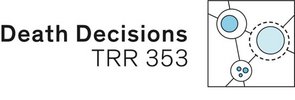B01: Host cell decisions between apoptosis, necroptosis and survival after infections with Herpes Simplex Virus 1 (HSV-1)
Project Leader: Christoph Borner
Herpes simplex virus type 1 (HSV-1) is a double-stranded DNA virus that infects permissive epithelial cells. During the early phase of infection host cell apoptosis and necroptosis are inhibited because HSV-1 encodes several proteins that directly block mediators of both cell death modes or activate the survival factor NFkB. This allows newly produced HSV-1 particles to be secreted by exocytosis. At later stages of infection these cells become lytic due to necroptosis. In other cells such as immune cells or fibroblasts, HSV-1 induces PUMA- and caspase 8-dependent apoptosis without major cell lysis. Finally, HSV-1 establishes a latent non-permissive infection of sensory neurons, which survive until virus production is reactivated. The molecular mechanisms, which determine host cell decisions between apoptosis, necroptosis and survival in different cell types are still ill-defined. In the first part of this proposal, we will investigate the relative contribution of (i) HSV-1 receptor (TNFRSF14/HVEM)- initiated NFkB signaling, (ii) caspase 8-inhibiting HSV-1 ribonucleotide reductase R1 and (iii) the PUMA-targeting HSV-1 miRNA H8 (miRH8) to the cell death protection of epithelial cells during the early phase of HSV-1. We will then identify when and by which molecular mechanisms these cells switch to necroptosis at later stages of infection. In the second part, we will study if TNFRSF14 death-inducing signaling complex (DISC) formation and caspase 8 activation, PUMA stabilization or both are responsible for driving apoptosis of immune cells and how viral factors such as R1, miRH8 or others are able to block necroptosis but not apoptosis in these cells. In the third part, we will investigate which of the cellular and viral factors contributing to cell death/survival switches regulate autophagy and how this influences the production and cellular release of HSV-1 particles and hence viral titers. We believe that a better knowledge of these mechanisms will improve our understanding of changes in cell survival/ death modes and the molecular links between various cell death and autophagic signaling pathways in general and how this may affect diseases associated with HSV-1 and other viruses in particular.


